2015 TOYOTA AVENSIS light
[x] Cancel search: lightPage 246 of 648
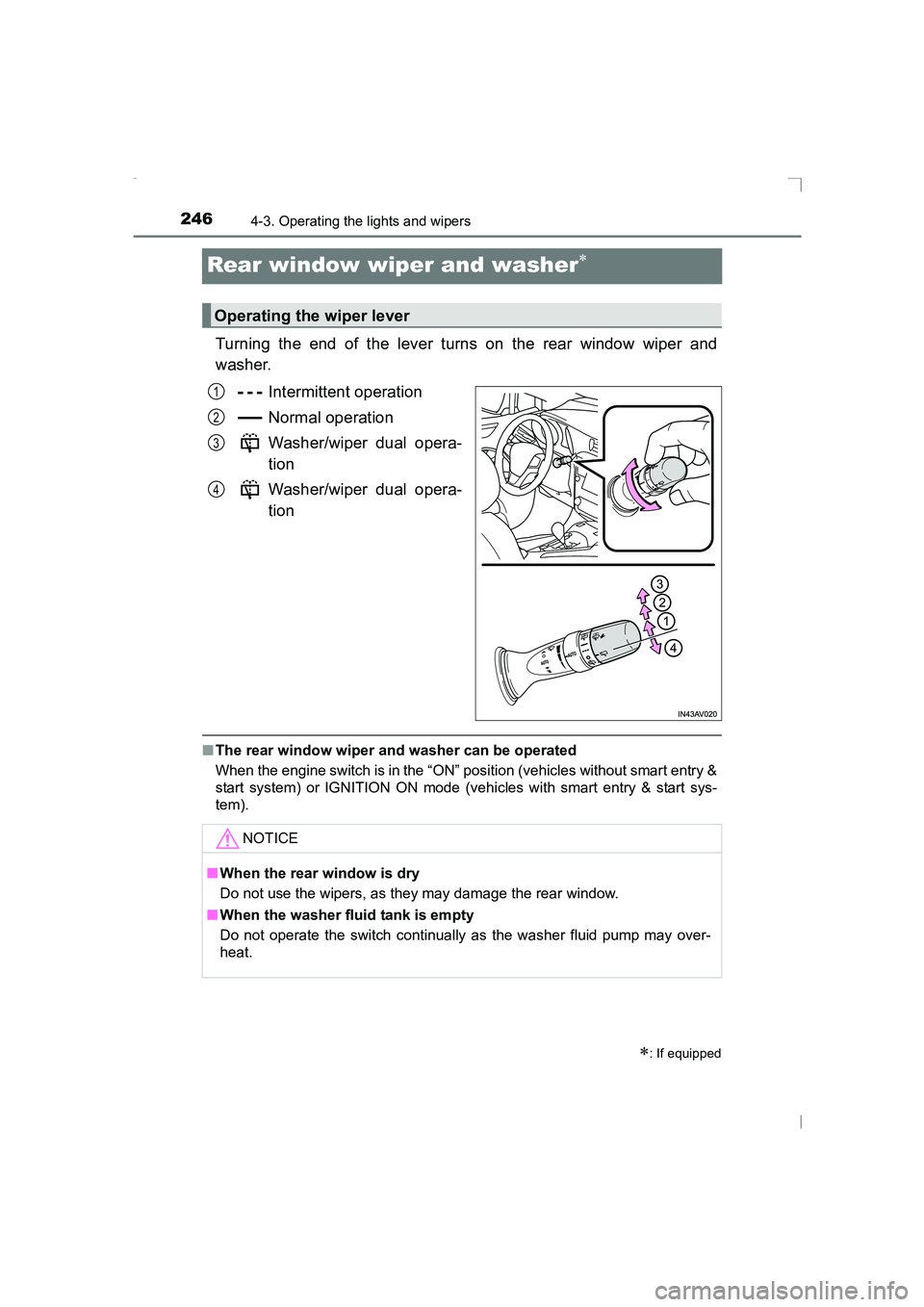
2464-3. Operating the lights and wipers
AVENSIS_OM_OM20C20E_(EE)
Rear window wiper and washer∗
Turning the end of the lever turns on the rear window wiper and
washer.Intermittent operation
Normal operation
Washer/wiper dual opera-
tion
Washer/wiper dual opera-
tion
■The rear window wiper and washer can be operated
When the engine switch is in the “ON” position (vehicles without smart entry &
start system) or IGNITION ON mode (vehicles with smart entry & start sys-
tem).
∗: If equipped
Operating the wiper lever
1
2
3
4
NOTICE
■When the rear window is dry
Do not use the wipers, as they may damage the rear window.
■ When the washer fluid tank is empty
Do not operate the switch continually as the washer fluid pump may over-
heat.
AVENSIS_OM_OM20C20E_(EE).book Page 246 Thursday, January 29, 2015 1:47 PM
Page 250 of 648

2504-4. Refueling
AVENSIS_OM_OM20C20E_(EE)
After refueling, turn the fuel tank
cap until you hear a click. Once
the cap is released, it will turn
slightly in the opposite direction.
Closing the fuel tank cap
WARNING
■ When replacing the fuel tank cap
Do not use anything but a genuine Toyota fuel tank cap designed for your
vehicle. Failure to do so may cause a fire or other incident which may result
in death or serious injury.
AVENSIS_OM_OM20C20E_(EE).book Page 250 Thursday, January 29, 2015 1:47 PM
Page 254 of 648
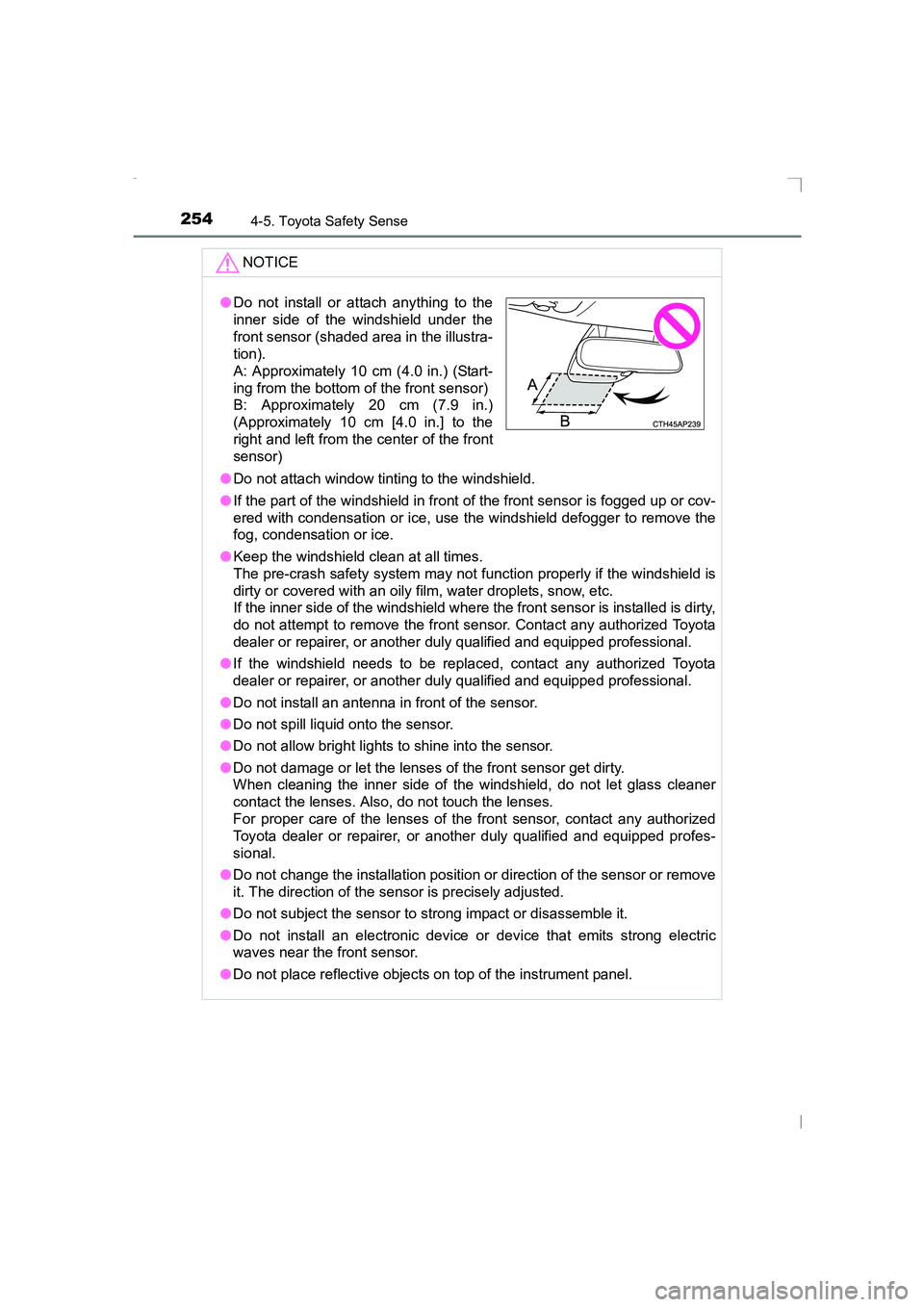
2544-5. Toyota Safety Sense
AVENSIS_OM_OM20C20E_(EE)NOTICE
●
Do not attach window tinting to the windshield.
● If the part of the windshield in front of the front sensor is fogged up or cov-
ered with condensation or ice, use the windshield defogger to remove the
fog, condensation or ice.
● Keep the windshield clean at all times.
The pre-crash safety system may not function properly if the windshield is
dirty or covered with an oily film, water droplets, snow, etc.
If the inner side of the windshield where the front sensor is installed is dirty,
do not attempt to remove the front sensor. Contact any authorized Toyota
dealer or repairer, or another dul y qualified and equipped professional.
● If the windshield needs to be replaced, contact any authorized Toyota
dealer or repairer, or another dul y qualified and equipped professional.
● Do not install an antenna in front of the sensor.
● Do not spill liquid onto the sensor.
● Do not allow bright lights to shine into the sensor.
● Do not damage or let the lenses of the front sensor get dirty.
When cleaning the inner side of the windshield, do not let glass cleaner
contact the lenses. Also, do not touch the lenses.
For proper care of the lenses of the front sensor, contact any authorized
Toyota dealer or repairer, or another duly qualified and equipped profes-
sional.
● Do not change the installation position or direction of the sensor or remove
it. The direction of the sensor is precisely adjusted.
● Do not subject the sensor to strong impact or disassemble it.
● Do not install an electronic device or device that emits strong electric
waves near the front sensor.
● Do not place reflective objects on top of the instrument panel.
●Do not install or attach anything to the
inner side of the windshield under the
front sensor (shaded area in the illustra-
tion).
A: Approximately 10 cm (4.0 in.) (Start-
ing from the bottom of the front sensor)
B: Approximately 20 cm (7.9 in.)
(Approximately 10 cm [4.0 in.] to the
right and left from the center of the front
sensor)
sec_04-05.fm Page 254 Friday, February 20, 2015 3:43 PM
Page 256 of 648
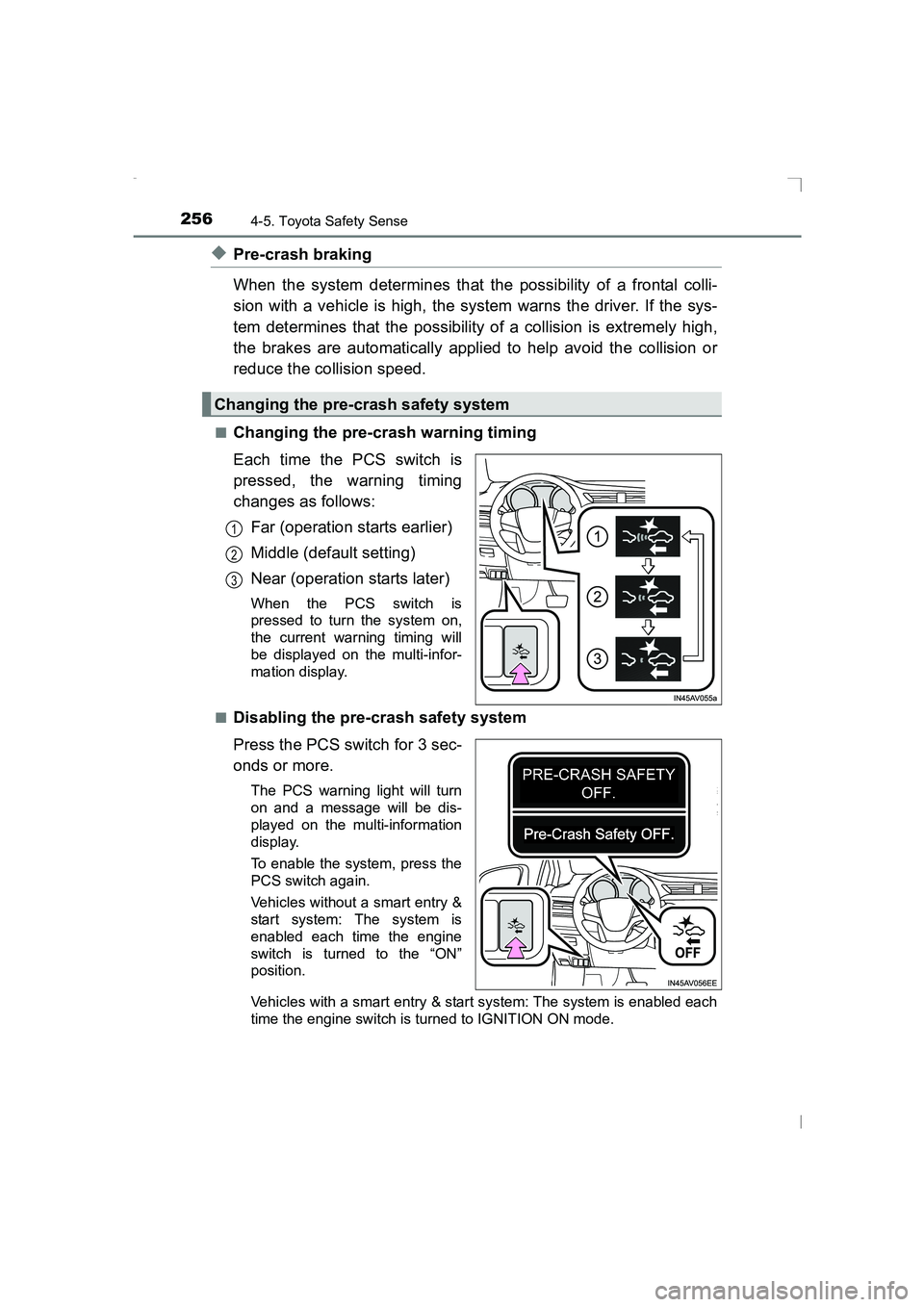
2564-5. Toyota Safety Sense
AVENSIS_OM_OM20C20E_(EE)
◆Pre-crash braking
When the system determines that the possibility of a frontal colli-
sion with a vehicle is high, the system warns the driver. If the sys-
tem determines that the possibility of a collision is extremely high,
the brakes are automatically applied to help avoid the collision or
reduce the collision speed.
■Changing the pre-crash warning timing
Each time the PCS switch is
pressed, the warning timing
changes as follows:Far (operation starts earlier)
Middle (default setting)
Near (operation starts later)
When the PCS switch is
pressed to turn the system on,
the current warning timing will
be displayed on the multi-infor-
mation display.
■
Disabling the pre-crash safety system
Press the PCS switch for 3 sec-
onds or more.
The PCS warning light will turn
on and a message will be dis-
played on the multi-information
display.
To enable the system, press the
PCS switch again.
Vehicles without a smart entry &
start system: The system is
enabled each time the engine
switch is turned to the “ON”
position.
Vehicles with a smart entry & start system: The system is enabled each
time the engine switch is turned to IGNITION ON mode.
Changing the pre-crash safety system
1
2
3
AVENSIS_OM_OM20C20E_(EE).book Page 256 Thursday, January 29, 2015 1:47 PM
Page 257 of 648

2574-5. Toyota Safety Sense
4
Driving
AVENSIS_OM_OM20C20E_(EE)
■Operational conditions
The pre-crash safety system is enabled and determines that the possibility of
a frontal collision with a vehicle (e xcept motorcycles and bicycles) is high.
● Pre-crash warning:
• Vehicle speed is approximately 15 to 140 km/h (10 to 87 mph).
• The relative speed between your vehicle and the vehicle ahead is greater
than approximately 15 km/h (10 mph).
● Pre-crash brake assist:
• Vehicle speed is approximately 30 to 80 km/h (19 to 50 mph).
• The relative speed between your vehicle and the vehicle ahead is greater
than approximately 30 km/h (19 mph).
● Pre-crash braking:
• Vehicle speed is approximately 10 to 80 km/h (7 to 50 mph).
• The relative speed between your vehicle and the vehicle ahead is greater
than approximately 10 km/h (7 mph).
The system may not operate in the following situations:
● If a battery terminal has been disconnected and reconnected and then the
vehicle has not been driven for a certain amount of time
● If VSC is disabled (only the pre-crash warning function will be operational)
● If the PCS warning light is flashing or illuminated
■ Cancelation of the pre-crash braking
●If either of the following situations occur while the pre-crash braking function
is operating, it will be canceled:
• The accelerator pedal is depressed strongly.
• The steering wheel is turned sharply or abruptly.
● If the vehicle is stopped by the operation of the pre-crash braking function,
the operation of the pre-crash braking function will be canceled after the
vehicle has been stopped for approximately 2 seconds.
AVENSIS_OM_OM20C20E_(EE).book Page 257 Thursday, January 29, 2015 1:47 PM
Page 258 of 648
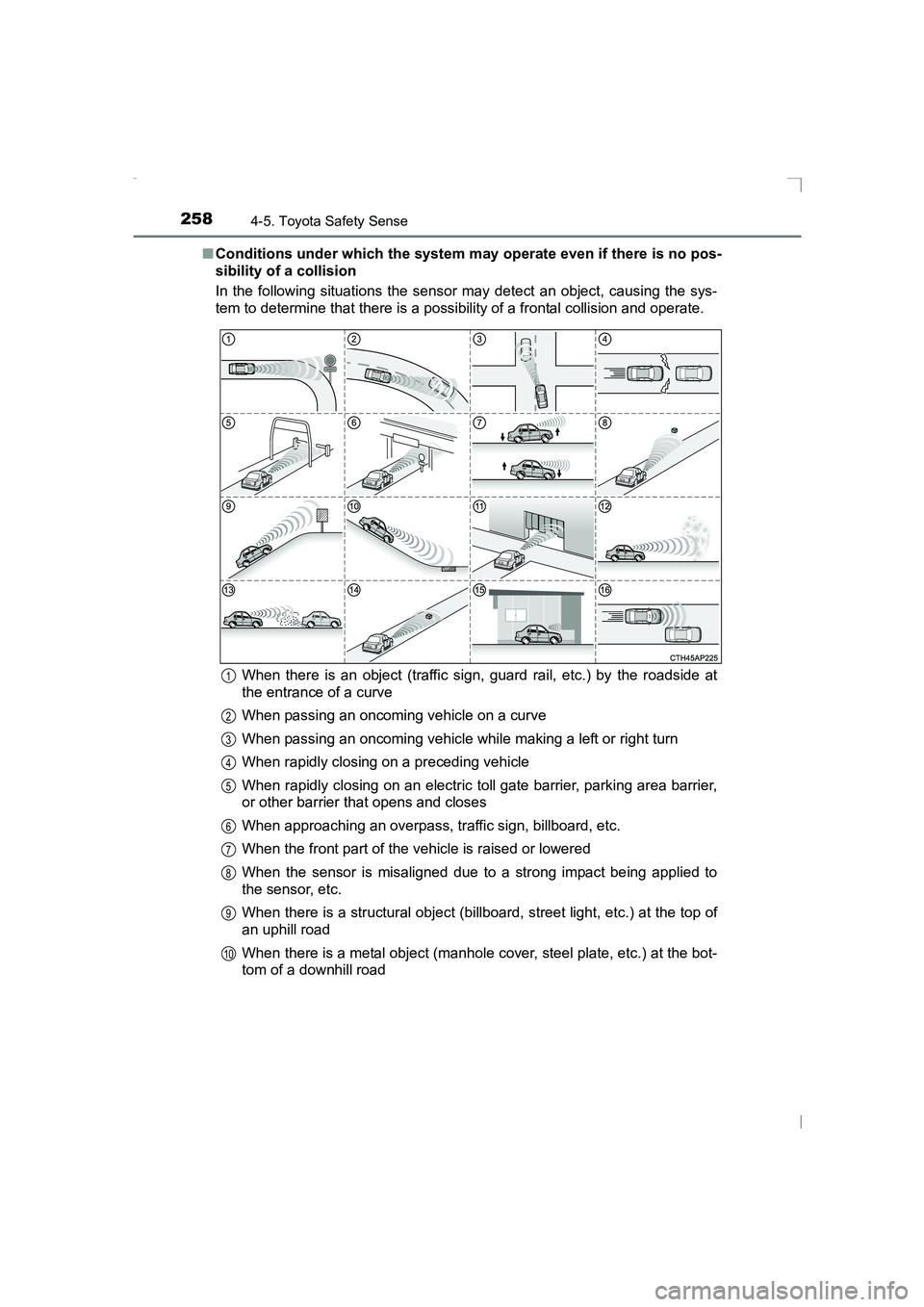
2584-5. Toyota Safety Sense
AVENSIS_OM_OM20C20E_(EE)■
Conditions under which the system may operate even if there is no pos-
sibility of a collision
In the following situations the sensor may detect an object, causing the sys-
tem to determine that there is a possibility of a frontal collision and operate.
When there is an object (traffic sign, guard rail, etc.) by the roadside at
the entrance of a curve
When passing an oncoming vehicle on a curve
When passing an oncoming vehicle while making a left or right turn
When rapidly closing on a preceding vehicle
When rapidly closing on an electric toll gate barrier, parking area barrier,
or other barrier that opens and closes
When approaching an overpass, traffic sign, billboard, etc.
When the front part of the vehicle is raised or lowered
When the sensor is misaligned due to a strong impact being applied to
the sensor, etc.
When there is a structural object (billboard, street light, etc.) at the top of
an uphill road
When there is a metal object (manhole cover, steel plate, etc.) at the bot-
tom of a downhill road
1
2
3
4
5
6
7
8
9
10
AVENSIS_OM_OM20C20E_(EE).book Page 258 Thursday, January 29, 2015 1:47 PM
Page 260 of 648
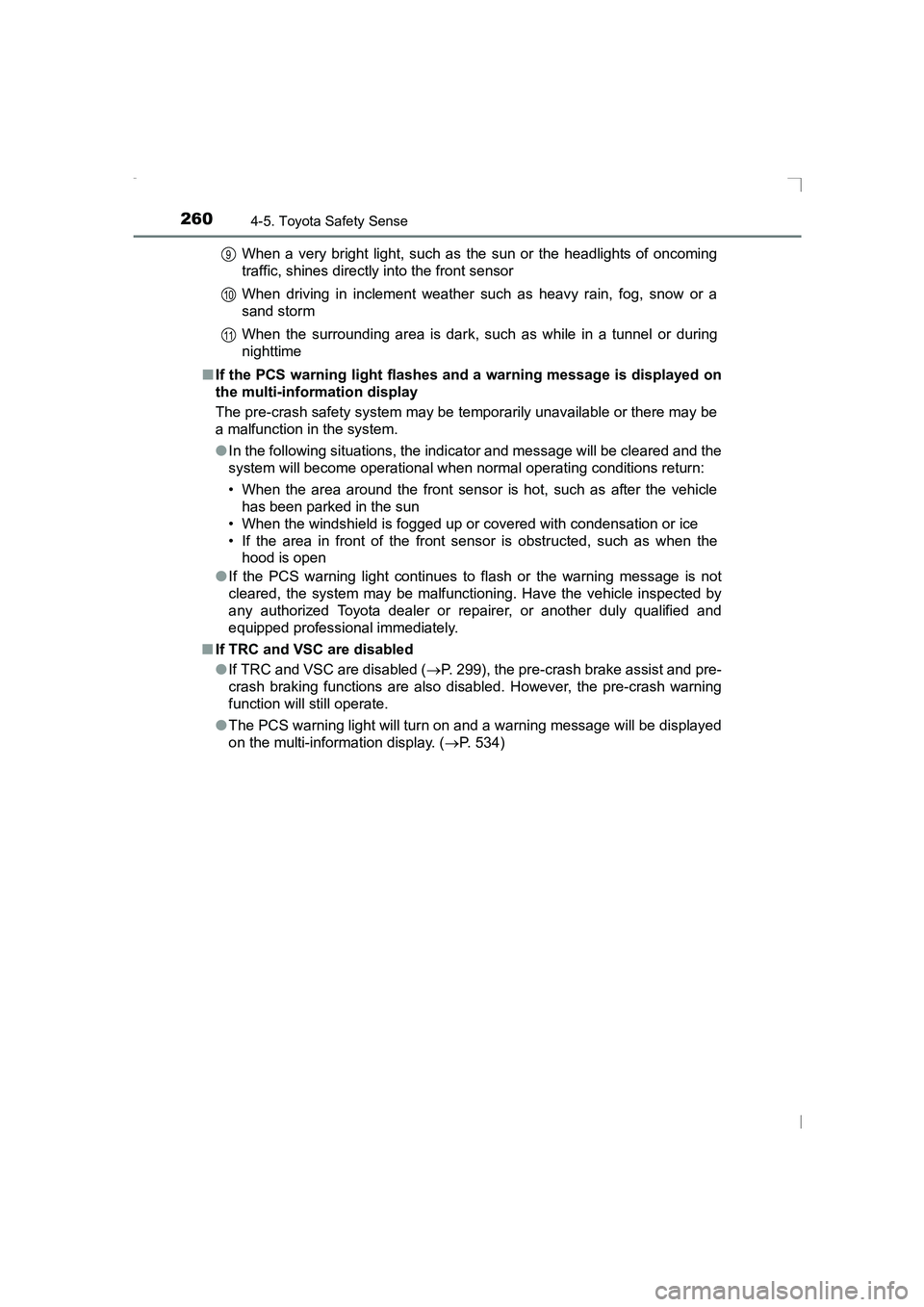
2604-5. Toyota Safety Sense
AVENSIS_OM_OM20C20E_(EE)When a very bright light, such as the sun or the headlights of oncoming
traffic, shines directly into the front sensor
When driving in inclement weather such as heavy rain, fog, snow or a
sand storm
When the surrounding area is dark, such as while in a tunnel or during
nighttime
■ If the PCS warning light flashes and a warning message is displayed on
the multi-information display
The pre-crash safety system may be temporarily unavailable or there may be
a malfunction in the system.
●In the following situations, the indicator and message will be cleared and the
system will become operational when normal operating conditions return:
• When the area around the front sensor is hot, such as after the vehicle
has been parked in the sun
• When the windshield is fogged up or covered with condensation or ice
• If the area in front of the front sens or is obstructed, such as when the
hood is open
● If the PCS warning light continues to flash or the warning message is not
cleared, the system may be malfunctioning. Have the vehicle inspected by
any authorized Toyota dealer or repairer, or another duly qualified and
equipped professional immediately.
■ If TRC and VSC are disabled
●If TRC and VSC are disabled ( →P. 299), the pre-crash brake assist and pre-
crash braking functions are also disabled. However, the pre-crash warning
function will still operate.
● The PCS warning light will turn on and a warning message will be displayed
on the multi-information display. ( →P. 534)
9
10
11
AVENSIS_OM_OM20C20E_(EE).book Page 260 Thursday, January 29, 2015 1:47 PM
Page 266 of 648

2664-5. Toyota Safety Sense
AVENSIS_OM_OM20C20E_(EE)■
Conditions in which the func tion may not operate correctly
In the following situations, the front sensor may be unable to recognize lane
markers causing the lane departure warning function to operate incorrectly.
However, this does not indicate a malfunction.
● When driving through an area, such as a tollbooth, a crossing or before a
ticket checkpoint
● When driving on a sharp curve
● When lane markers are extremel y narrow or extremely wide
● When the vehicle leans to one side an unusual amount due to a heavy load
or improper tire inflation pressure
● When the following distance between your vehicle and the vehicle ahead is
extremely short
● When the lane markers are yellow (These may be more difficult for the sys-
tem to recognize compared to white markers.)
● When the lane markers are broken, Botts’ dots (raised pavement markers)
or stones
● When the lane markers are on a curb etc.
● When lane markers are obscured or part ially obscured by sand, dirt, etc.
● When there are shadows on the road running parallel with lane markers, or
if a shadow covers the lane markers
● When driving on a particularly bright road surface, such as concrete
● When driving on a road surface that is bright due to reflected light
● When driving in a location where the light level changes rapidly, such as the
entrance to or exit from a tunnel
● When sunlight or the headlights of oncoming vehicles are shining directly
into the camera lens
● When driving on roads that are branching or merging
● When driving on a road surface that is wet due to rain, previous rainfall,
standing water, etc.
● When the vehicle experiences strong up-and-down motion such as when
driving on an extremely rough road or on a seam in the pavement
● When headlight brightness at nighttime is reduced due to dirt on the lenses,
or when the headlights are misaligned
● When driving on winding roads or roads that are uneven
● When driving on rough or unpaved roads
● When the windshield is dirty, or if raindrops, condensation or ice are adher-
ing to the windshield.
● When the heater is blowing to the feet, the upper part of the windshield may
get fogged up and have a negative effect.
● When cleaning the inside of the windshi eld, touching the lens or getting
glass cleaner on the lens may have a negative effect.
AVENSIS_OM_OM20C20E_(EE).book Page 266 Thursday, January 29, 2015 1:47 PM